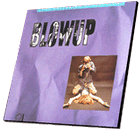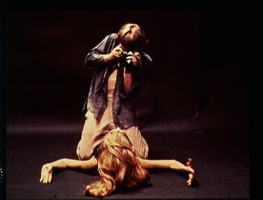

UK/Italy film school
1967
111 min.
Director: Michelangelo Antonioni
CAV: out-of-print collectible
2 discs, catalog # CC1148L
 Newspapers and magazines were just beginning to detail the phenomenon
known as "Swinging London" when Blowup burst upon the movie
world in 1966. The look, the style, the clothes, the music, the mood
and just about everything else connected with a "scene" everyone on
earth seemed to be talking about was suddenly there, up on the screen,
with all the impact and the immediacy of which only the movies are
capable. Moreover it was all being offered up in that most attractive
of moviemaking forms, the murder-mystery thriller. Commercial success
was a foregone conclusion. Still, curiously enough, none of this
appeared in the cards at the outset. For Blowup didn't begin
its life as a cannily trendy product of studio filmmaking, but rather
as the very personal expression of the imagination of one of European
art cinema's greatest talents, Michelangelo Antonioni.
Newspapers and magazines were just beginning to detail the phenomenon
known as "Swinging London" when Blowup burst upon the movie
world in 1966. The look, the style, the clothes, the music, the mood
and just about everything else connected with a "scene" everyone on
earth seemed to be talking about was suddenly there, up on the screen,
with all the impact and the immediacy of which only the movies are
capable. Moreover it was all being offered up in that most attractive
of moviemaking forms, the murder-mystery thriller. Commercial success
was a foregone conclusion. Still, curiously enough, none of this
appeared in the cards at the outset. For Blowup didn't begin
its life as a cannily trendy product of studio filmmaking, but rather
as the very personal expression of the imagination of one of European
art cinema's greatest talents, Michelangelo Antonioni.
The creator of L'Avventura, La Notte, Eclipse,
and Red Desert would hardly have been anyone's first choice to
chronicle the London scene, so devoted was this Italian filmmaker to
stark tales of his own country's alienated intellectuals and decaying
upper classes. Yet from the very first shots of Blowup --
cutting between a pack of masquerading students on a spree, and a
group of tramps leaving an overnight shelter -- it's clear that
Antonioni's cool "outsider's" eye was just what was needed to tell
this story of a "with it" fashion photographer who unwittingly
uncovers a murder. Antonioni's clear-eyed, measured tone perfectly
offsets the frenetic pace of the lives his film details.
David Hemmings gives an incredibly vigorous performance as the
photographer here (clearly modeled after David Bailey), catching every
nuance of this elusive, quicksilver personality. Making his fortune in
high fashion shots, the photographer seeks to create art on the side
with candid photography (he was among the group of tramps in the
film's opening, having spent the night with them in order to get
pictures). But this seemingly simple pastime proves to be complicated
when one afternoon in a public park he follows a couple engaged in a
romantic tryst.
On the surface it looks rather banal -- a man and a woman
innocently kissing. But when the woman (Vanessa Redgrave) catches
sight of the photographer's activity she confronts him, demanding the
pictures. Playfully, teasingly, he puts her off by giving her a fake
roll of film and keeping the real one for himself. It's only when he
develops the film in his studio that he discovers that what he thought
was merely an illicit afternoon interlude was really a set-up for a
murder.
It is in this central sequence (Chapter 11) that Blowup
begins to move into high gear -- and the visual scrupulousness of
Antonioni's technique begins to pay off. The situation is reminiscent
of Hitchcock's Rear Window. But where the photographer-hero of
that film had his own sight and hearing to guide him, the protagonist
of Blowup is working only through the evidence of his
photographs. As he assembles and examines them, the truth slowly
begins to emerge as a figure with a gun is suddenly observed hiding in
the bushes alongside the couple.
It's a clear case of murder, confirmed when the photographer
returns to the park at night and finds the body. But what does the
murder mean in a society as "cool" as this one? Antonioni, rather
than reach for easy answers, supplies further questions as he follows
the photographer through a day and a night, deciphering the photos
while at the same time dealing with the distractions of his
high-pressure world. We see him romping with a pair of teenage
would-be models Jane Birkin and Gillian Hills), manipulating every
move of his most important fashion mannequin (Verushka), pausing
briefly to relax with the wife of a painter friend (Sarah Miles) only
to take off again, losing his way in a London rife with pop music (the
group The Yardbirds make an appearance in Chapter 15) and "pot"
parties.
Blowup was a film plainly earmarked for maximum enjoyment
through repeated viewings, so subtle was its technique in detailing
its very visual mystery story. And now through CAV laserdisc that
pleasure is increased a hundred-fold. For Blowup in CAV
laserdisc is, in fact, Super-Blow-Up. The photographic details the
hero uncovers in Chapter 11 can be examined even further through
freeze-framing by the home viewer. Moreover, the scene that is the
basis of the photographs -- Chapter 7 -- can be dissected in like
manner as well.
If you've never seen Blowup before, prepare yourself for one
of the cinema's most unique experiences. If you have seen it before,
prepare as well for rediscovering -- much like the film's hero --
something you only thought you knew.
-- DAVID EHRENSTEIN
Credits
Director: Michelangelo Antonioni
Producer: Carlo Ponti
Executive Producer: Pierre Rouve
Screenplay: Michelangelo Antonioni, Tonino Guerra
Story: Michelangelo Antonioni
Inspired by "Blow-Up" by: Julio Cortazar
Director of Photography: Carlo di Palma
Art Director: Assheton Gorton
Film Editor: Frank Clarke
Production Manager: Donald Toms
Sound Recordist: Robin Gregory
Dress Designer: Jocelyn Richards
Make-Up: John Cowan
Music: Herbert Hancock
Transfer
This edition of Blowup was transferred from a 35mm master print
in the correct aspect ratio of 1.66:1. The soundtrack was mastered
from a 35mm magnetic track.




